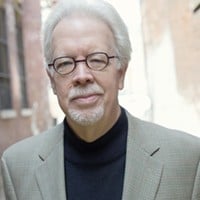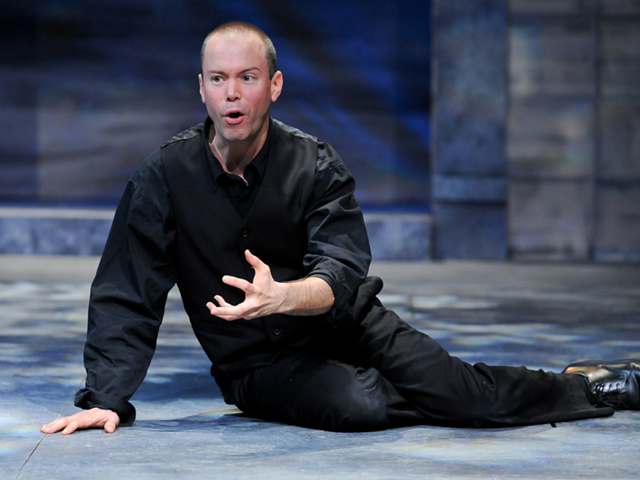Whether or not you’re a Shakespeare aficionado, you’ve certainly heard of Hamlet, generally considered one of his greatest plays, if not one of the greatest works ever written for the stage. It was first presented around 1600 and has been more or less constantly on stages and movie screens around the world for more than four centuries. The tale of the indecisive Prince of Denmark, who struggles with avenging his father’s murder, has remained a topic of constant conversation among theater critics and literary analysts, and lines from Hamlet are familiar to most of us who speak English, whether or not we’ve seen a production of the play.
Judge for yourself — or revel in it again — when Cincinnati Shakespeare Company presents Hamlet, opening Friday for a four-week run at its Race Street theater downtown. It’s the fifth time in 20 seasons that CSC has staged the classic tragedy about something “rotten in the state of Denmark.”
Hamlet is not merely a tale of revenge. It’s about existence itself, as the young tragic hero asks the succinct, perhaps unanswerable, question: “To be, or not to be?” He is in fact considering his own existence and whether he should end it so as to escape doubts about his father’s — the king’s — death, his uncle’s likely role in that event and his mother’s quick marriage to her husband’s likely murderer. He vacillates between action and inaction, voicing numerous monologues about his future, making the role of Hamlet (approximately 1,500 lines) the largest of any Shakespearean character and the play that’s the longest of the Bard’s 38 surviving works. It’s almost never performed in its entirety, with most directors judiciously trimming the script for modern productions.
The exploration of existence has kept Hamlet fascinating for ages, and it’s been mined in a closely related form by a contemporary playwright, Tom Stoppard, whose Rosencrantz and Guildenstern Are Dead reshapes elements of Hamlet in an intriguing way. Stoppard elevated two of Shakespeare’s minor roles to central characters in his 1966 script (first staged at the Edinburgh Fringe Festival). Next month (Feb. 14-March 9), CSC shifts the cast of Hamlet into Stoppard’s mirror-image play for the first time in the company’s history.
In Shakespeare’s play, Rosencrantz and Guildenstern, college chums of Hamlet, are recruited by King Claudius to dispense with his troublesome nephew. They have just a few lines and are more plot elements than flesh-and-blood men. We know that Hamlet replaces Claudius’ orders to murder him with a directive to dispense with the two men, and subsequently we hear that “Rosencrantz and Guildenstern are dead,” the last mention of two forgettable characters.
Stoppard makes them memorable, however, even as they struggle with the apparent meaninglessness of their own existence, replete with distinct echoes of Hamlet’s own conundrum. But the pair’s musings dig much deeper into the realm of absurdity, with distinct echoes of plays such as Samuel Beckett’s Waiting for Godot (which CSC staged memorably in 2000). Other characters have a hard time distinguishing which of them is Rosencrantz and which is Guildenstern; Rosencrantz, in fact, frequently confuses his own name with Guildenstern’s.
Stoppard’s play opens with the two betting on a tossed coin. Rosencrantz consistently calls heads and wins 92 consecutive flips. This leads to their speculation that other forces are at play and that their fates are not within their own control. In fact, their lives are in the hands not only of the scheming King Claudius, but also of Shakespeare’s play, in which they play minor — and rather inconsequential — roles.
The playwright uses chunks of Shakespeare’s script to move the action forward, interspersed with scenes of extended action and speculation by the pair. For instance, on the road to Elsinore they meet a troupe of tragedians, the actors who Hamlet later uses to enact a scene that might reveal his uncle’s role in the king’s murder. Rosencrantz and Guildenstern learn that actors have no existence without an audience — an artistic echo of their own plight.
By returning the cast of the upcoming production of Hamlet to perform Stoppard’s play, CSC will offer audiences a rare opportunity to delve into and compare the issues explored by two theatrical works and two immensely talented playwrights, divided by hundreds of years but united in their examination of the human condition and, perhaps, the absurdity of existence. Paired with Stoppard’s classic “variation,” it’s another example of how lucky we are to be theatergoers in Cincinnati.
CONTACT RICK PENDER: [email protected]







